电子科技大学:《语言学通论 General Linguistics》课程教学资源(课件讲稿)语义学——Sentence meaning(Predication Analysis)
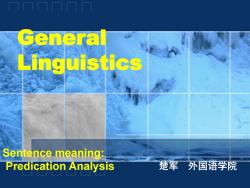
General Linguistics Sentence meaning: Predication Analysis 楚军外国语学院
Sentence meaning: Predication Analysis 楚军 外国语学院 General Linguistics

The Semantic Structure of Sentences How about this hypothesis? --the meaning of a sentence is merely the sum of the meanings of the words and other constituents which compose it. Without 'predication analysis',we could not tell the difference of meaning between: My wife has a new dog. My new wife has a dog. My new dog has a wife. (All these would have to be regarded as synonymous with the help of 'CA'.)
The Semantic Structure of Sentences How about this hypothesis? --the meaning of a sentence is merely the sum of the meanings of the words and other constituents which compose it. Without ‘predication analysis’ , we could not tell the difference of meaning between: My wife has a new dog. My new wife has a dog. My new dog has a wife. (All these would have to be regarded as synonymous with the help of ‘CA’.)

Predications,Arguments and Predicates Predication(述谓): For the following three sentences: The children ate their dinner. Did the children eat their dinner? Eat your dinner,children! Leaving aside differences of tense and pronouns, these sentences share a common content Children eat dinner'and this kind of structure is considered under the name of 'predication
Predications, Arguments and Predicates • Predication (述谓): For the following three sentences: The children ate their dinner. Did the children eat their dinner? Eat your dinner, children! Leaving aside differences of tense and pronouns, these sentences share a common content ‘Children eat dinner’ and this kind of structure is considered under the name of ‘predication’
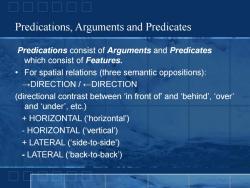
Predications,Arguments and Predicates Predications consist of Arguments and Predicates which consist of Features. For spatial relations (three semantic oppositions): →DIRECTION/←-DIRECTION (directional contrast between 'in front of'and 'behind','over' and 'under',etc.) HORIZONTAL ('horizontal') HORIZONTAL ('vertical') LATERAL ('side-to-side') LATERAL (back-to-back')
Predications consist of Arguments and Predicates which consist of Features. • For spatial relations (three semantic oppositions): →DIRECTION / ←DIRECTION (directional contrast between ‘in front of’ and ‘behind’ , ‘over’ and ‘under’ , etc.) + HORIZONTAL (‘horizontal’) - HORIZONTAL (‘vertical’) + LATERAL (‘side-to-side’) - LATERAL (‘back-to-back’) Predications, Arguments and Predicates
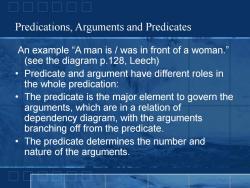
Predications,Arguments and Predicates An example "A man is was in front of a woman. (see the diagram p.128,Leech) Predicate and argument have different roles in the whole predication: The predicate is the major element to govern the arguments,which are in a relation of dependency diagram,with the arguments branching off from the predicate. The predicate determines the number and nature of the arguments
An example “A man is / was in front of a woman.” (see the diagram p.128, Leech) • Predicate and argument have different roles in the whole predication: • The predicate is the major element to govern the arguments, which are in a relation of dependency diagram, with the arguments branching off from the predicate. • The predicate determines the number and nature of the arguments. Predications, Arguments and Predicates
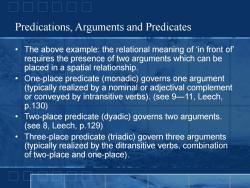
Predications,Arguments and Predicates The above example:the relational meaning of 'in front of requires the presence of two arguments which can be placed in a spatial relationship. One-place predicate (monadic)governs one argument (typically realized by a nominal or adjectival complement or conveyed by intransitive verbs).(see 9-11,Leech, p.130) Two-place predicate (dyadic)governs two arguments (see 8,Leech,p.129) Three-place predicate (triadic)govern three arguments (typically realized by the ditransitive verbs,combination of two-place and one-place)
• The above example: the relational meaning of ‘in front of’ requires the presence of two arguments which can be placed in a spatial relationship. • One-place predicate (monadic) governs one argument (typically realized by a nominal or adjectival complement or conveyed by intransitive verbs). (see 9—11, Leech, p.130) • Two-place predicate (dyadic) governs two arguments. (see 8, Leech, p.129) • Three-place predicate (triadic) govern three arguments (typically realized by the ditransitive verbs, combination of two-place and one-place). Predications, Arguments and Predicates
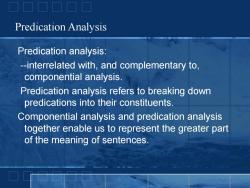
Predication Analysis Predication analysis: --interrelated with,and complementary to, componential analysis. Predication analysis refers to breaking down predications into their constituents. Componential analysis and predication analysis together enable us to represent the greater part of the meaning of sentences
Predication analysis: --interrelated with, and complementary to, componential analysis. Predication analysis refers to breaking down predications into their constituents. Componential analysis and predication analysis together enable us to represent the greater part of the meaning of sentences. Predication Analysis

Predication Analysis Three general types of predicate: Two-place as P2; One-place as P1; No-place as Po.(meteorological utterances:It is raining.It will be warm tomorrow.) Thus three types of predication:(13,p.131, Leech)
Predication Analysis • Three general types of predicate: • Two-place as P2; • One-place as P1; • No-place as P0. (meteorological utterances: It is raining. It will be warm tomorrow.) • Thus three types of predication: (13, p.131, Leech)
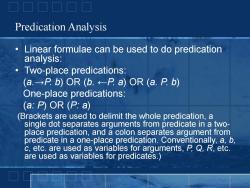
Predication Analysis Linear formulae can be used to do predication analysis: Two-place predications: (a.-P.b)OR (b.<P.a)OR (a.P.b) One-place predications: (a:P)OR (P:a) (Brackets are used to delimit the whole predication,a single dot separates arguments from predicate in a two- place predication,and a colon separates argument from predicate in a one-place predication.Conventionally,a,b, c,etc.are used as variables for arguments,P Q,R,etc. are used as variables for predicates.)
• Linear formulae can be used to do predication analysis: • Two-place predications: (a.→P. b) OR (b. ←P. a) OR (a. P. b) One-place predications: (a: P) OR (P: a) (Brackets are used to delimit the whole predication, a single dot separates arguments from predicate in a two- place predication, and a colon separates argument from predicate in a one-place predication. Conventionally, a, b, c, etc. are used as variables for arguments, P, Q, R, etc. are used as variables for predicates.) Predication Analysis

Predication Analysis 1)A predication-componential formulae:(see 7a,p.132, Leech) 2)A simple linear arrangement omitting+,↑,and→for unmarked or dominant terms: (Human Adult Male Singular.Direction-Lateral Human Adult-Male Singular) 'A man in front of a woman' (Breed-Singular:Big)'Alsatians be large 3)A mixed version: (Vehicle Singular a.P Concrete Singular b) --part of the meaning of 'The red car hit the wall
Predication Analysis 1) A predication-componential formulae: (see 7a, p.132, Leech) 2) A simple linear arrangement omitting + , ↑,and → for unmarked or dominant terms: (Human Adult Male Singular . Direction –Lateral . Human Adult –Male Singular) ‘A man in front of a woman’ (Breed –Singular: Big) ‘Alsatians be large’ 3) A mixed version: (Vehicle Singular a. P. Concrete Singular b) --part of the meaning of ‘The red car hit the wall’
按次数下载不扣除下载券;
注册用户24小时内重复下载只扣除一次;
顺序:VIP每日次数-->可用次数-->下载券;
- 电子科技大学:《语言学通论 General Linguistics》课程教学资源(课件讲稿)语义学——Componential Analysis.pdf
- 电子科技大学:《语言学通论 General Linguistics》课程教学资源(课件讲稿)语义学——Context, changes in word meaning, figures of speech.pdf
- 电子科技大学:《语言学通论 General Linguistics》课程教学资源(课件讲稿)语义学——Semantics(Sense Relations).pdf
- 电子科技大学:《语言学通论 General Linguistics》课程教学资源(课件讲稿)语义学——Types of word-meaning.pdf
- 电子科技大学:《语言学通论 General Linguistics》课程教学资源(课件讲稿)07 Semantics(Introduction).pdf
- 电子科技大学:《语言学通论 General Linguistics》课程教学资源(课件讲稿)06 Functional Grammar.pdf
- 电子科技大学:《语言学通论 General Linguistics》课程教学资源(课件讲稿)05 句法 Syntax.pdf
- 电子科技大学:《语言学通论 General Linguistics》课程教学资源(课件讲稿)04 Formalist Approach.pdf
- 电子科技大学:《语言学通论 General Linguistics》课程教学资源(课件讲稿)03 Formalist Approach.pdf
- 电子科技大学:《语言学通论 General Linguistics》课程教学资源(课件讲稿)02 句法 Syntax.pdf
- 电子科技大学:《语言学通论 General Linguistics》课程教学资源(课件讲稿)01 Introduction(主讲:楚军).pdf
- 山东省“成人教育特色课程”项目配套教材:《大学语文》课程教材电子版(主编:戴永新).pdf
- 聊城大学:《大学语文》课程教学资源(阅读文献)中国现当代文学经典作品选.pdf
- 聊城大学:《大学语文》课程教学资源(阅读文献)外国文学经典作品选.pdf
- 聊城大学:《大学语文》课程教学资源(阅读文献)中国古代文学经典作品选.pdf
- 聊城大学:《大学语文》课程教学资源(电子教案讲义,共十五讲).docx
- 运城学院:《文学概论 literature theory》课程教学资源(电子教案,打印版,2/2,共两编八章).pdf
- 运城学院:《文学概论 literature theory》课程教学资源(电子教案,打印版,1/2,共三篇八章).pdf
- 运城学院:《文学概论 literature theory》课程教学资源(教学大纲,打印版).pdf
- 运城学院:《秘书写作 Daily practical Writing》课程PPT教学课件(事务文书写作)15.总结述职报告.ppt
- 电子科技大学:《语言学通论 General Linguistics》课程教学资源(课件讲稿)10 Langugae, culture & society.pdf
- 电子科技大学:《语言学通论 General Linguistics》课程教学资源(课件讲稿)09 Pragmatics(Utterance Meaning).pdf
- 电子科技大学:《语言学通论 General Linguistics》课程教学资源(课件讲稿)形态学 Morphology.pdf
- 电子科技大学:《语言学通论 General Linguistics》课程教学资源(课件讲稿)认知语言学中的相关话题 Cognitive Linguistics.pdf
- 弟子规(全文).pdf
- 《中国语言文化 Chinese Language and Culture》课程教学资源(书籍阅读材料)《中国古典哲学名著选读》郭齐勇.pdf
- 《中国语言文化 Chinese Language and Culture》课程教学资源(书籍阅读材料)《唐诗三百首》中英文对照(许渊冲)300 Tang Poems(Classified by Theme).pdf
- 《中国语言文化 Chinese Language and Culture》课程教学资源(书籍阅读材料)《二十四诗品校注译评》祖保泉.pdf
- 《中国语言文化 Chinese Language and Culture》课程教学资源(书籍阅读材料)《近代中国之种族观念》刘东.pdf
- 《中国语言文化 Chinese Language and Culture》课程教学资源(书籍阅读材料)《中国现代女作家与中国革命1905-1948》颜海平.pdf
- 《中国语言文化 Chinese Language and Culture》课程教学资源(书籍阅读材料)《世界秩序与文明等级》全球史研究的新路径(主编:刘禾).pdf
- 《中国语言文化 Chinese Language and Culture》课程教学资源(书籍阅读材料)《叫魂》SOULSTEALERS - The Chinese Sorcery Scare of 1768〔美〕孔飞力(1768年中国妖术大恐慌).pdf
- 电子科技大学:《中国语言文化 Chinese Language and Culture》课程教学资源(课件讲稿)导论(聂韬).pdf
- 电子科技大学:《中国语言文化 Chinese Language and Culture》课程教学资源(课件讲稿)第一讲 周易.pdf
- 电子科技大学:《中国语言文化 Chinese Language and Culture》课程教学资源(课件讲稿)第七讲 谶纬之学.pdf
- 电子科技大学:《中国语言文化 Chinese Language and Culture》课程教学资源(课件讲稿)第三讲 山海经.pdf
- 电子科技大学:《中国语言文化 Chinese Language and Culture》课程教学资源(课件讲稿)第二讲 尚书.pdf
- 电子科技大学:《中国语言文化 Chinese Language and Culture》课程教学资源(课件讲稿)第五讲 道家与魏晋风度.pdf
- 电子科技大学:《中国语言文化 Chinese Language and Culture》课程教学资源(课件讲稿)第八讲 诗歌的创作翻译与批评之平仄格律.pdf
- 电子科技大学:《中国语言文化 Chinese Language and Culture》课程教学资源(课件讲稿)第六讲 汉赋(中国古代辞赋).pdf
